Occupation
Al-Khalil/Hebron, Palestine, 2016–17
series of 32 photographs,
26,7 x 40 cm; 40 × 26,7 cm; 40 × 60 cm; 60 × 40 cm; 100 × 150 cm,
chromogenic prints
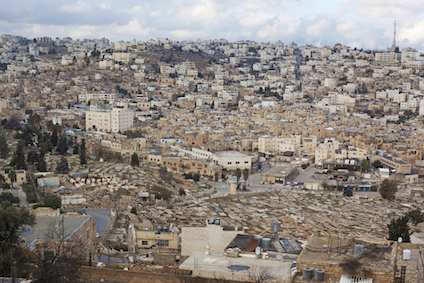 |
Ahlam Shibli, untitled (Occupation no. 1), al-Khalil/Hebron, Palestine, 2016–17, chromogenic print, 100 x 150 cm. Islamic cemetery, al-Shuhada Street, Hay al-Yahud/Avraham Avinu settlement, Old Town, northern part of the city, al-Khalil, December 25, 2016. View from al-Rahma hill. Jews have free access to al-Shuhada Street; Palestinian access is limited to residents who are registered by the Israel Defense Forces (IDF) at the checkpoint, but only on foot. They have to renew their registration every year. All Palestinian shops in al-Shuhada Street and in Hay al-Yahud/Avraham Avinu settlement are closed by Israeli military order. Most of the Palestinian houses are deserted due to constant harassment by the IDF and settlers. Courtesy of the artist, © Ahlam Shibli |
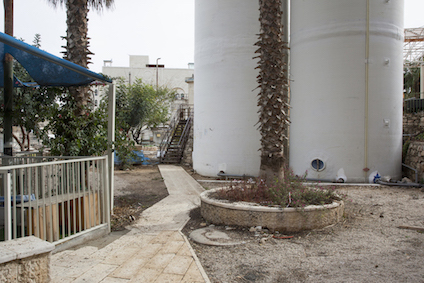 |
Ahlam Shibli, untitled (Occupation no. 2), al-Khalil/Hebron, Palestine, 2016–17, chromogenic print, 40 × 60 cm. Al-Shuhada Street, water towers at the Beit Romano settlement, Old Town, al-Khalil, December 4, 2016. Established in 1983, the Beit Romano settlement consists of a Yeshiva and a camp of the Israel Defense Forces (IDF). Palestinian access to the area is completely prohibited. According to the settlers, the Beit Romano building was erected in 1879 as a guesthouse by a merchant from Istanbul, Avraham Romano. In 1912 the Lubavitcher Rebbe purchased the property to establish the Torath Emeth Yeshiva, and in 1917 the British Mandate authorities confiscated the building and used it as their headquarters and police station. In 1948 the Jordanian authorities opened a boys' school named Madrasat Osama ibn Munqidh at the site. In 1981 the IDF closed the school. One year later they took possession of it, and in 1983 it was used to establish the Yeshiva Shavei Hevron. In July 2008 the Israeli Minister of Defense approved the construction of a multi-story structure adjacent to the existing Yeshiva as dormitories for additional students. Courtesy of the artist, © Ahlam Shibli |
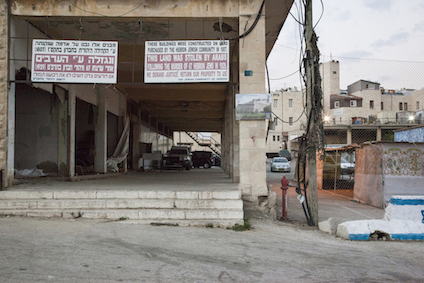 |
Ahlam Shibli, untitled (Occupation no. 3), al-Khalil/Hebron, Palestine, 2016–17, chromogenic print, 40 × 60 cm. Al-Shuhada Street, Old Wholesale Vegetable Market, Hay al-Yahud/Avraham Avinu settlement, Old Town, al-Khalil, October 21, 2016. The largest settlement in the Old Town is built around the old Jewish quarter. The settlers claim that it was bought by Jewish exiles in 1540 and therefore has to be considered the property of the Jewish community of Hebron. After the al-Haram al-Ibrahimi massacre that left 29 Palestinians dead and more than 150 wounded, the Israeli government closed the old wholesale vegetable market in 1994 and prohibited Palestinians entering the area. The massacre was carried out by an American-Israeli member of the Israeli Kach movement, which is considered a terrorist organization by the European Union and the United States. In 2001, during the Second Intifada, settlers occupied the old wholesale vegetable market and the surrounding area. Courtesy of the artist, © Ahlam Shibli |
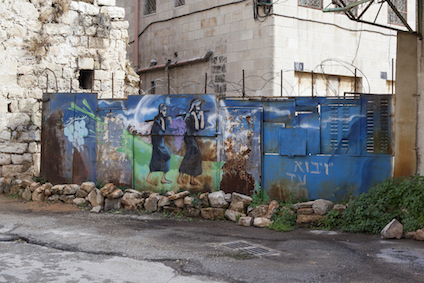 |
Ahlam Shibli, untitled (Occupation no. 4), al-Khalil/Hebron, Palestine, 2016–17, chromogenic print, 40 × 60 cm. Bab al-Khan Street, Hay al-Yahud/Avraham Avinu settlement, Old Town, al-Khalil, December 21, 2016. The Israel Defense Forces (IDF) blocked Bab al-Khan Street before the Second Intifada. Since 2001, Palestinians have had no access to either side of the road, and the entire area is surrounded by Israeli checkpoints and blocked roads with the exception of the roads connecting the settlements. The painting on the metal wall showing two men carrying a large cluster of grapes refers to Numbers 13: "(1) And the LORD spake unto Moses, saying, (2) Send thou men, that they may search the land of Canaan, which I give unto the children of Israel . . . (22) And they ascended by the south, and came unto Hebron; where Ahiman, Sheshai, and Talmai, the children of Anak, were. (Now Hebron was built seven years before Zoan in Egypt.) (23) And they came unto the brook of Eshcol, and cut down from thence a branch with one cluster of grapes, and they bare it between two upon a staff." Courtesy of the artist, © Ahlam Shibli |
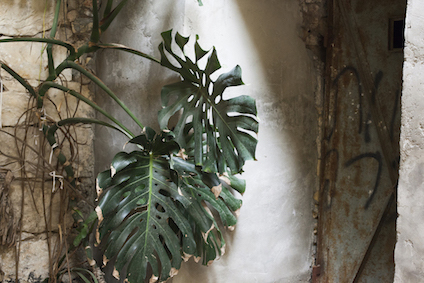 |
Ahlam Shibli, untitled (Occupation no. 5), al-Khalil/Hebron, Palestine, 2016–17, chromogenic print, 26,7 × 40 cm. House of the al-Sharabati family, Hay al-Yahud/Avraham Avinu settlement, Old Town, al-Khalil, December 21, 2016. In 1979, under the protection of the Israeli Defense Forces (IDF), settlers arrived with bulldozers to tear down the old Jewish houses in Hay al-Yahud, the Jewish neighborhood, in order to construct new buildings for additional settlers, thus creating the Avraham Avinu settlement. During this operation they destroyed parts of the houses of the al-Sharabati and Bader families. The families were expelled from their houses in July 2002. Courtesy of the artist, © Ahlam Shibli |
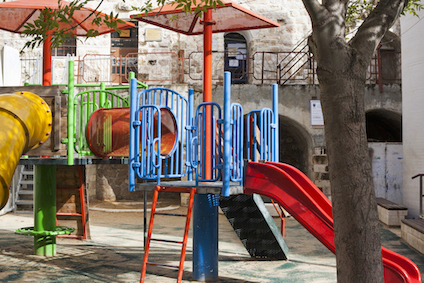 |
Ahlam Shibli, untitled (Occupation no. 6), al-Khalil/Hebron, Palestine, 2016–17, chromogenic print, 40 × 60 cm. Playground, Souq al-Haddadeen, Hay al-Yahud/Avraham Avinu settlement, Old Town, al-Khalil, December 21, 2016. The wall behind the playground of the settlement is the backside of Palestinian blacksmith's shops and several offices on the upper floor, all closed in 2001 by order of the Israeli military. Palestinians are absolutely prohibited from entering the area of Souq al-Haddadeen (blacksmith's shops). The settlers opened the workshops from the back to enlarge the area of the playground; they use the spaces on the top floor as their community offices. Courtesy of the artist, © Ahlam Shibli |
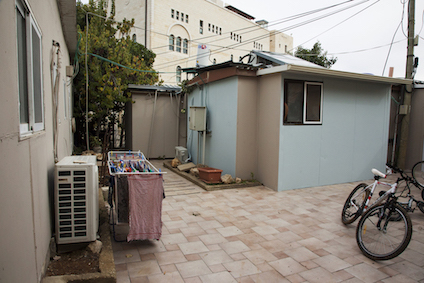 |
Ahlam Shibli, untitled (Occupation no. 7), al-Khalil/Hebron, Palestine, 2016–17, chromogenic print, 40 × 60 cm. Chizkiyahu settlement, Old Town, al-Khalil, December 4, 2016. Within the confines of the main Hebron military camp at the central bus station, where the State of Israel issued a permission in 2012 to build an apartment house with twelve units, the settlers installed temporary caravan houses for several families to occupy the land for their purposes. The Chizkiyahu settlement is named after the chief rabbi of Hebron from 1901–04, Hezekiah Medini, who arrived in Palestine from Crimea in 1899 and died in 1904. Courtesy of the artist, © Ahlam Shibli |
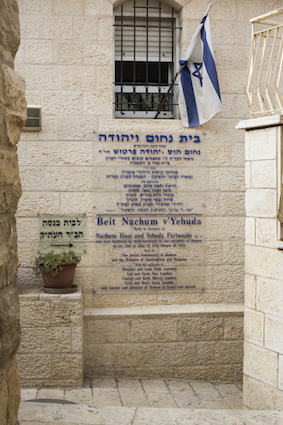 |
Ahlam Shibli, untitled (Occupation no.8), al-Khalil/Hebron, Palestine, 2016–17, chromogenic print, 40 × 26,7 cm. Hay al-Yahud/Avraham Avinu settlement, Old Town, al-Khalil, December 21, 2016. Mounted on a residential building next to the path leading to the Old Synagogue, a memorial plaque not only commemorates an attack of March 20, 1995 but also describes the governmental involvement in erecting new settlements in al-Khalil; it is generally known that every time Israeli settlers are killed by a Palestinian, the Israeli government grants the construction of new residential buildings in the settlements and provides them with financial support. Courtesy of the artist, © Ahlam Shibli |
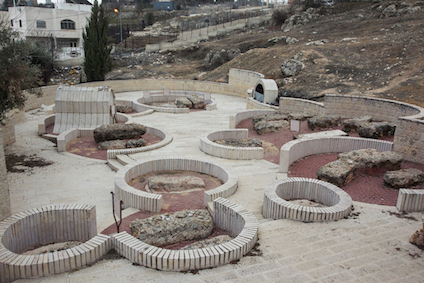 |
Ahlam Shibli, untitled (Occupation no. 9), al-Khalil/Hebron, Palestine, 2016–17, chromogenic print, 40 x 60 cm. Old Jewish Cemetery, Torbet al-Yahud Street, Jabal al-Rahma neighborhood, al-Khalil, January 26, 2017. The Old Jewish Cemetery is completely barred from Palestinian entry. It contains four sections: the old section (Sephardic section) for prominent rabbinical sages and community figures, which was renovated to take the shape of a grape cluster; the graves with the remains of fifty-nine victims of the 1929 Hebron massacre; the military section; and a contemporary cemetery for the settlers. Courtesy of the artist, © Ahlam Shibli |
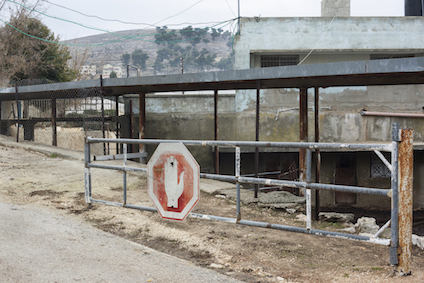 |
Ahlam Shibli, untitled (Occupation no. 10), al-Khalil/Hebron, Palestine, 2016–17, chromogenic print, 40 x 60 cm. Al-Arrub Agriculture High School, Shuyukh al-Arrub, December 24, 2016. The al-Arrub refugee camp is located east of the al-Arrub Agriculture High School, built in 1964, and approximately ten kilometers north of al-Khalil. It was established after the Nakbah, in 1949. Courtesy of the artist, © Ahlam Shibli |
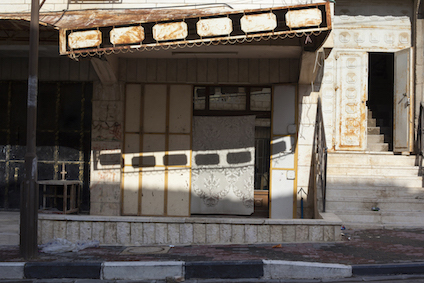 |
Ahlam Shibli, untitled (Occupation no. 11), al-Khalil/Hebron, Palestine, 2016–17, chromogenic print, 40 x 60 cm. Al-Ja'abrah street, al-Ja'abari neighborhood, Old Town, al-Khalil, December 17, 2016. The road that leads to al-Haram al-Ibrahimi (Abraham's Mosque/Cave of the Patriarchs) is blocked by an Israeli army checkpoint. Only residents who are registered by the Israeli Defense Forces (IDF) at the checkpoint are allowed to pass, but only on foot. The ground floor of the residential building houses a hair salon for women. Next door is a blacksmith's shop. Courtesy of the artist, © Ahlam Shibli |
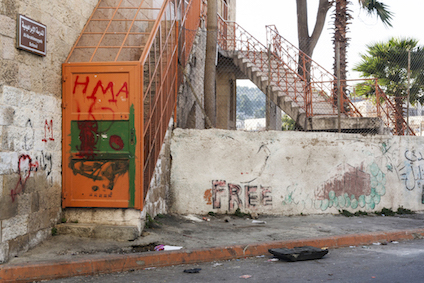 |
Ahlam Shibli, untitled (Occupation no. 12), al-Khalil/Hebron, Palestine, 2016–17, chromogenic print, 40 x 60 cm. Al-Ibrahimeyeh School, Old Town, al-Khalil, December 12, 2016. Built in 1911 by the Ottoman Empire, the al-Ibrahimeyeh School is the oldest school in al-Khalil. The surrounding wall was built in 2011 to celebrate the school's centenary and to protect it from settlers' attacks. "Free Palestine," painted repeatedly on this wall, was changed by settlers to "Free Israel." Shown is the back entrance of the school, which is protected against settlers' attacks. The Israeli army does not allow Palestinians to use the main entrance at al-Shuhada street. The school serves some four hundred pupils. Courtesy of the artist, © Ahlam Shibli |
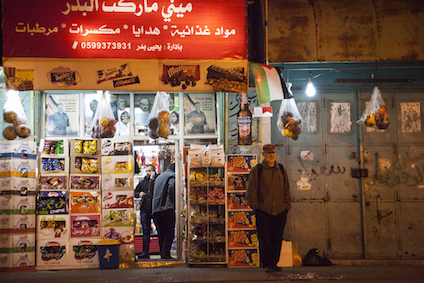 |
Ahlam Shibli, untitled (Occupation no. 13), al-Khalil/Hebron, Palestine, 2016–17, chromogenic print, 40 x 60 cm. Mini market al-Badr, Bab al-Zawyeh Square, al-Shuhada Street, Old Town, al-Khalil, January 26, 2017. Al-Shuhada street, one-and-a-half kilometers long, leads to al-Haram al-Ibrahimi (Abraham's Mosque/Cave of the Patriarchs), the central wholesale vegetable market of the region, the central bus station, and the police station. In 1994, after the al-Haram al-Ibrahimi massacre, Israel banned Palestinians from entering the street, and eighty shops were closed by military order. Ultimately the exclusion of Palestinians from the street led to the closing of all four hundred Palestinian shops and private offices in the area, the Palestinian municipal and governmental offices, and the central bus station, which was turned into an Israeli army base. Courtesy of the artist, © Ahlam Shibli |
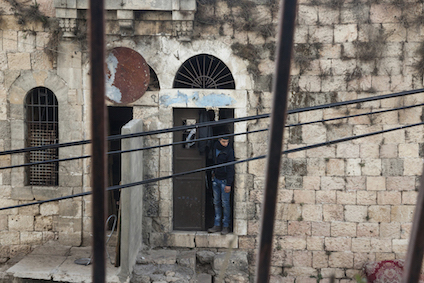 |
Ahlam Shibli, untitled (Occupation no. 14), al-Khalil/Hebron, Palestine, 2016–17, chromogenic print, 40 x 60 cm. The house of the al-Ja'abari brothers, Abu Khalaf neighborhood, Old Town, al-Khalil, November 25, 2016. The house is located in the street the settlers of Kiryat Arba, the first Israeli settlement in al-Khalil, used to reach Me'arat Ha-Makhpela (Cave of the Patriarchs) for prayers every Friday and Saturday. On their way they attacked Palestinians and threw stones at glass windows of Palestinian houses. The two families who were living in the house moved to a different place. Now it is used to hold their sheep and goats. Courtesy of the artist, © Ahlam Shibli |
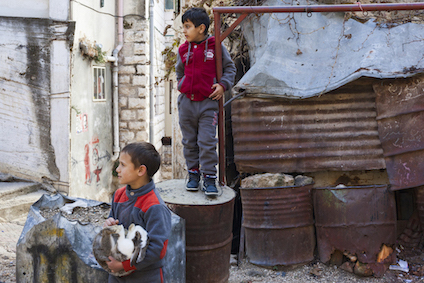 |
Ahlam Shibli, untitled (Occupation no. 15), al-Khalil/Hebron, Palestine, 2016–17, chromogenic print, 40 x 60 cm. 'Ain al-Qurneh neighborhood, Old Town, al-Khalil, December 20, 2016. Families use metal barrels and containers filled with stones, debris, and concrete to separate their properties from their neighbors. Courtesy of the artist, © Ahlam Shibli |
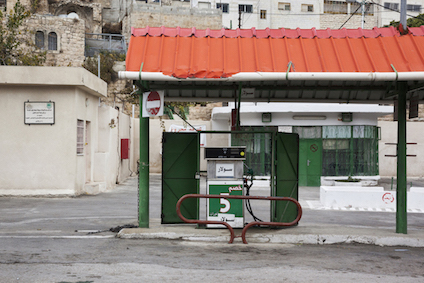 |
Ahlam Shibli, untitled (Occupation no. 16), al-Khalil/Hebron, Palestine, 2016–17, chromogenic print, 40 x 60 cm. Al-Shallalah Street, Old Town, al-Khalil, December 2, 2016. The petrol station was renovated by Lajnat al-I'amar (Hebron Rehabilitation Committee) with the support of The Arab Fund for Economic and Social Development based in Kuwait. Lajnat al-I'amar works to protect the Old Town of al-Khalil from being further occupied by settlers, by maintaining and reusing abandoned buildings that are close to Israeli settlements and also by upgrading the infrastructure in order to reconnect the Old Town to other parts of the city. Courtesy of the artist, © Ahlam Shibli |
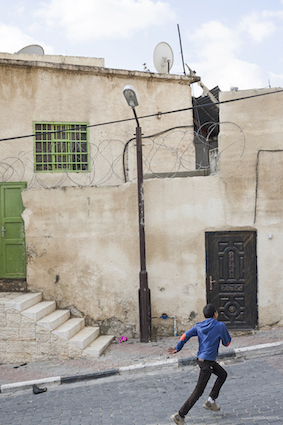 |
Ahlam Shibli, untitled (Occupation no. 17), al-Khalil/Hebron, Palestine, 2016–17, chromogenic print, 60 x 40 cm. Khallet Hadour Street, Old Town, al-Khalil, December 20, 2016. A family installed razor barbed wire on top of their wall to prevent people from climbing over. Due to the serious injuries it can cause, this wire has a strong psychological effect on people. Usually this kind of wire is under tension, and when cut, it recoils, unrolls, lashes out, and strikes the person cutting. Courtesy of the artist, © Ahlam Shibli |
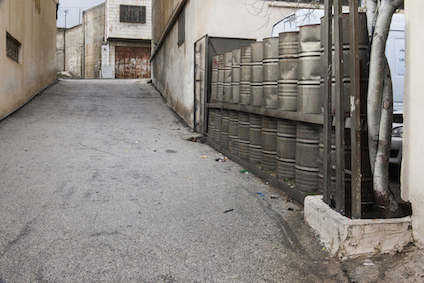 |
Ahlam Shibli, untitled (Occupation no. 18), al-Khalil/Hebron, Palestine, 2016–17, chromogenic print, 40 x 60 cm. Residential building of the al-Rajabi family, Tareq ben Ziyad Street, al-Mashrqa al-Tahta neighborhood, Old Town, al-Khalil, January 27, 2017. The family blocked the entrance to their yard from the byroad of Jabal al-Rahmah that leads to an important road for settlers. The settler road connects all settlements in the city, and only settlers are permitted to drive on it. All other streets leading to that road have been blocked with concrete blocks, metal structures, or barrels by the Israeli army. Entire Palestinian neighborhoods are affected by these closures. Courtesy of the artist, © Ahlam Shibli |
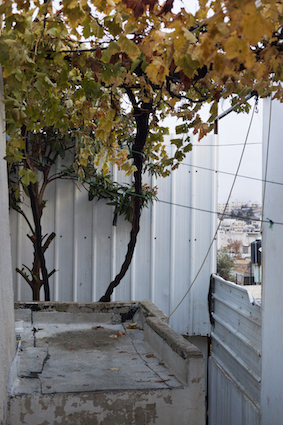 |
Ahlam Shibli, untitled (Occupation no. 19), al-Khalil/Hebron, Palestine, 2016–17, chromogenic print, 40 x 26,7 cm. House of Masarra al-Swaity, al-Ja'abari neighborhood, Old Town, al-Khalil, December 14, 2016. In order to protect themselves from thieves and from being seen by passersby and neighbors, the family installed metal sheets around their house. Courtesy of the artist, © Ahlam Shibli |
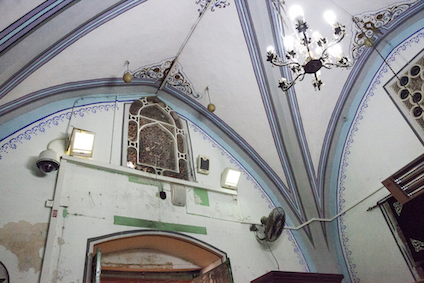 |
Ahlam Shibli, untitled (Occupation no. 20), al-Khalil/Hebron, Palestine, 2016–17, chromogenic print, 40 x 60 cm. Al-Haram al-Ibrahimi, Old Town, al-Khalil, October 17, 2016. The mosque came under Israel military rule on June 8, 1967 when al-Khalil was occupied by Israel. In February 25, 1994, a settler, Baruch Goldstein, opened fire on worshipers in al-Haram al-Ibrahimi, killing 29 Palestinians and wounding more than 150. The State of Israel closed the mosque and the Old Town for six months allegedly to investigate the massacre, which resulted in the division of al-Haram al-Ibrahimi between Muslims and Jews and the conversion of 60 % of it into a synagogue. Israel used barriers and iron gates to separate the two parts and placed military observation posts inside and around the building. On the roads leading to the mosque they installed iron gates and structures for inspection and limiting access. They also put surveillance cameras inside and outside the mosque. Courtesy of the artist, © Ahlam Shibli |
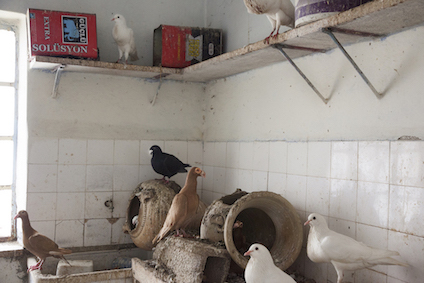 |
Ahlam Shibli, untitled (Occupation no. 21), al-Khalil/Hebron, Palestine, 2016–17, chromogenic print, 26,7 x 40 cm. Old house of the Sufyan al-Ja'abari family, al-Tullab Street, al-Khalil, January 25, 2017. Sufyan breeds pigeons and goats in his family's old house. The settlement Giv'at Ha'avot adjoins the family house and includes the Israeli Ja'abrah prison and police station. Both are used against Palestinians as well as Israeli activists who oppose the occupation. Courtesy of the artist, © Ahlam Shibli |
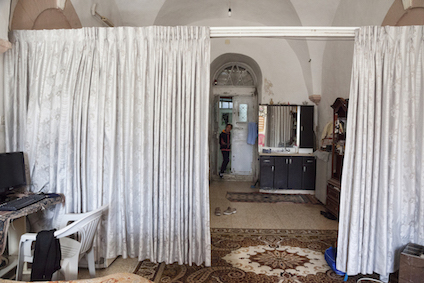 |
Ahlam Shibli, untitled (Occupation no. 22), al-Khalil/Hebron, Palestine, 2016–17, chromogenic print, 40 x 60 cm. House of the Mohamed al-Ja'abari family, al-Ja'abarah Street, al-Ja'abari neighborhood, Old Town, al-Khalil, December 7, 2016. The house was built by Hussein al-Ja'abari in 1899 in the Ottoman style and is one of the richly decorated houses in the city. The house is located in a neighborhood that Palestinians are not allowed to enter unless they are residents, and only on foot; visitors are allowed only with army permission. Such neighborhoods can only be accessed through gates and checkpoints. Courtesy of the artist, © Ahlam Shibli |
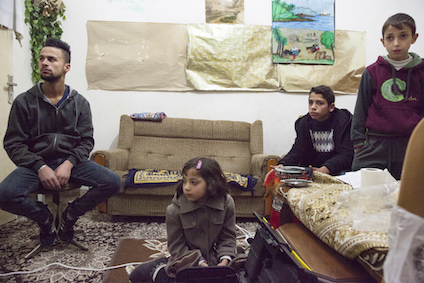 |
Ahlam Shibli, untitled (Occupation no. 23), al-Khalil/Hebron, Palestine, 2016–17, chromogenic print, 40 x 60 cm. The house of the Hashem and Nisreen Azzeh family, Othman ben Affan Street, Tel Rumeida, al-Khalil, December 4, 2016. The three children of Hashem Azzeh—Younis, Khaled, and Hanan—together with their cousin Ahmad. They are watching a technician install a television set, donated by a Danish solidarity delegation. Hashem Azzeh was killed by the Israeli Defense Forces (IDF) on October 21, 2015, poisoned by tear gas that was used in a clash between young Palestinians and Israeli forces. Courtesy of the artist, © Ahlam Shibli |
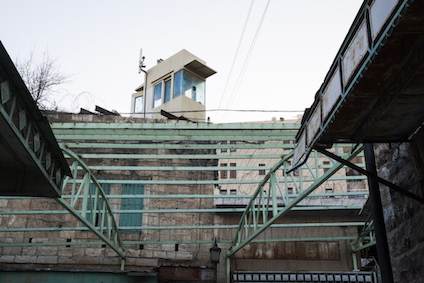 |
Ahlam Shibli, untitled (Occupation no. 24), al-Khalil/Hebron, Palestine, 2016–17, chromogenic print, 40 x 60 cm. Al-Shallalah Old Street, Old Town, al-Khalil, November 25, 2016. Positioned to guard the Beit Romano settlement, the observation post was installed on the roof of the house of the al-Haddad family by the Israeli Defense Forces (IDF). Courtesy of the artist, © Ahlam Shibli |
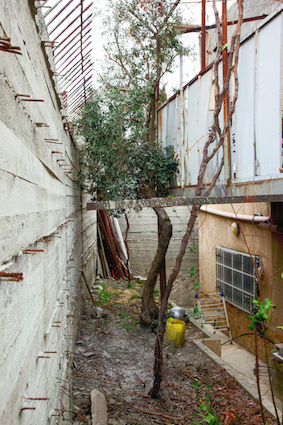 |
Ahlam Shibli, untitled (Occupation no. 25), al-Khalil/Hebron, Palestine, 2016–17, chromogenic print, 60 x 40 cm. House of the Sultan family, Old Jewish Cemetery, Torbet al-Yahud Street, Jabal al-Rahma neighborhood, al-Khalil, January 26, 2017. The wall on the property of the Sultan family surrounds the Old Jewish Cemetery and was built in memory of Yosef and Helen Simon by one of their granddaughters. Yosef Simon was born in 1887 in Quierschied, Germany, and was murdered in Theresienstadt, Czechoslovakia, in February 1943; Helen Simon was born 1891 in Ichenhausen, Germany. She was murdered in Auschwitz, Poland, in May 1944. Courtesy of the artist, © Ahlam Shibli |
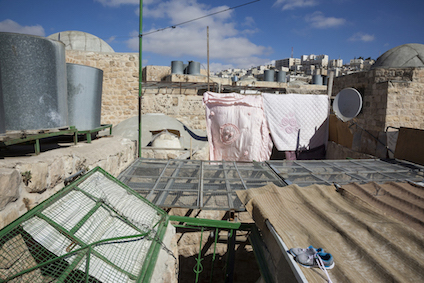 |
Ahlam Shibli, untitled (Occupation no. 26), al-Khalil/Hebron, Palestine, 2016–17, chromogenic print, 40 x 60 cm. House of the Sakher al-Muhtaseb family, al-Qasaba Street, Old Town, al-Khalil, October 23, 2016. The house is located on top of the Hamam Sidna Ibrahim that was converted into a museum and visitor center. To protect themselves from the aggression of settlers, who not only throw stones but also garbage to the inner courtyard of their house, the family installed a metal grid that can be opened to access the roof and another part of the house where they breed pigeons. Courtesy of the artist, © Ahlam Shibli |
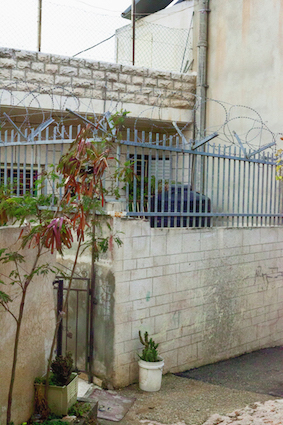 |
Ahlam Shibli, untitled (Occupation no. 27), al-Khalil/Hebron, Palestine, 2016–17, chromogenic print, 60 x 40 cm. Al-Zahed Street, al-Sheikh neighborhood, Old Town, al-Khalil, December 19, 2016. Razor barbed wire and metal fencing were installed to protect the house of an old lady from thieves. Courtesy of the artist, © Ahlam Shibli |
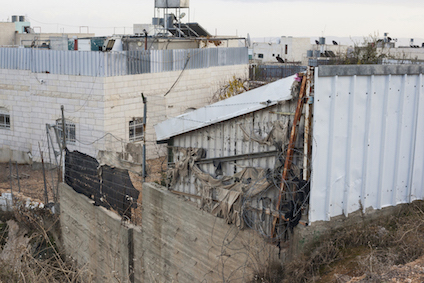 |
Ahlam Shibli, untitled (Occupation no. 28), al-Khalil/Hebron, Palestine, 2016–17, chromogenic print, 40 x 60 cm. Al-Juneidi neighborhood, al-Khalil, December 25, 2016. Zinc sheets on the roof and barbed wire at the edge of the property, on which hang ragged clothes, are supposed to screen the view and ward off people. Al-Juneidi is the name of one of the largest families in al-Khalil. Courtesy of the artist, © Ahlam Shibli |
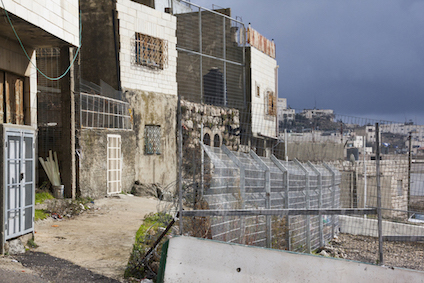 |
Ahlam Shibli, untitled (Occupation no. 29), al-Khalil/Hebron, Palestine, 2016–17, chromogenic print, 40 x 60 cm. Bani Salim Street, al-Salaimeh neighborhood, Old Town, al-Khalil, January 27, 2017. Close to the checkpoint on the corner of Bani Salim Street and al-Mahawer Street separating the al-Salaimeh neighborhood from the Old Town. The families installed several metal grids to protect themselves from stones and objects thrown on them by settlers who pass by on their way to Me'arat Ha-Makhpela (Cave of the Patriarchs). Palestinians are prohibited from traveling by car on this street. Courtesy of the artist, © Ahlam Shibli |
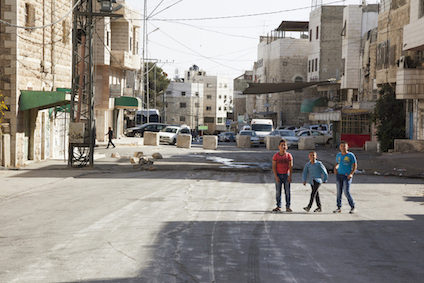 |
Ahlam Shibli, untitled (Occupation no. 30), al-Khalil/Hebron, Palestine, 2016–17, chromogenic print, 100 x 150 cm. Al-Sahleh Street, al-Qaitoun neighborhood, Old Town, al-Khalil, October 20, 2016. The Abu al-Rish checkpoint located in al-Sahleh Street, south of al-Haram al-Ibrahimi (Abraham's Mosque/Cave of the Patriarchs), is named after the Abu al-Rish mosque and shrine next to it. The checkpoint separates the Abu Sunaina and al-Qaitoun neighborhoods from the neighborhoods of the Old Town. It also separates the neighborhood from the oldest school in al-Khalil, the al-Ibrahimeyeh School, and from al-Hajariya Girls School. Palestinians are allowed to pass only on foot. The infrastructure of the checkpoint was expanded in July 2016, and since it reopened the Israeli Defense Forces (IDF) have prohibited Palestinians between the ages of sixteen and thirty-four from passing. Courtesy of the artist, © Ahlam Shibli |
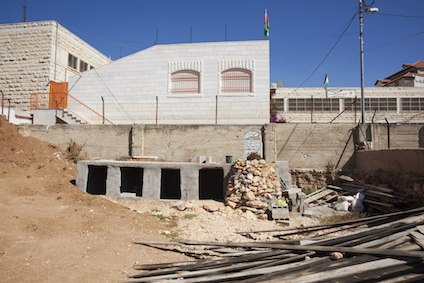 |
Ahlam Shibli, untitled (Occupation no. 31), al-Khalil/Hebron, Palestine, 2016–17, chromogenic print, 40 x 60 cm. Al-Haj Ishaq al-Qawasmi Girls Secondary School, al-Shuhada New Cemetery, al-Sheikh neighborhood, al-Khalil, October 24, 2016. Kelsar Oweiwi was killed by the Israeli army in February 2017, when she attacked a soldier at a checkpoint in the Old Town of al-Khalil with a fruit knife. In front of her grave is a small basket in which anyone who visits the grave can put some money. This money is meant for poor people or young children, who may take it when passing by. Courtesy of the artist, © Ahlam Shibli |
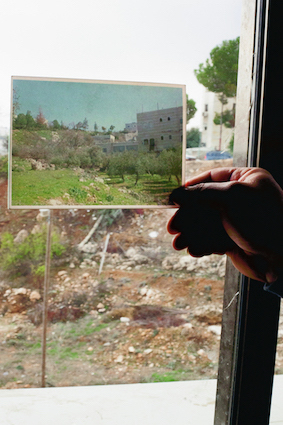 |
Ahlam Shibli, untitled (Occupation no. 32), al-Khalil/Hebron, Palestine, 2016–17, chromogenic print, 60 x 40 cm. House of the Samih and May Da'ana family, Wadi al-Nasarah neighborhood, al-Khalil, December 17, 2016. Samih and May Da'ana and their five children are living right next to the settlement Kiryat Arba. For security reasons the Israeli army cleared their land, turning it into a no man's land only accessible to soldiers and security personnel of the settlement. After having been attacked several times with stones and rifle shots the Da'anas are not using the rooms facing the settlement any more. Soldiers of the Israeli army often come to the house and even stay there overnight. Courtesy of the artist, © Ahlam Shibli |
